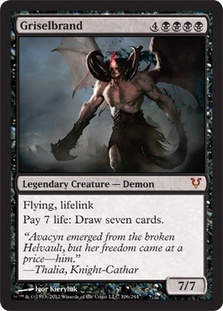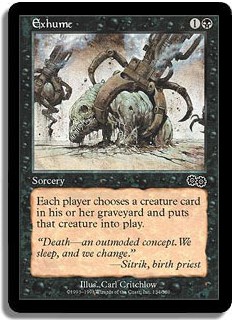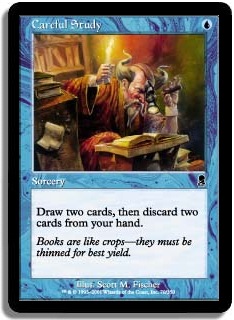I still remember it clearly: when I started really getting into Legacy a few years back, my worst nightmare was to be paired against a strong player piloting Reanimator. Maybe it was the speed of the deck or my unfamiliarity with the matchup, or maybe it subconsciously had something to do with the morbid flavor behind the strategy. Maybe there’s just something about Underground Sea that makes you shutter when you sit across the table from it. But reasons aside, for two and a half long years Reanimator has hung like a dark cloud over my Legacy career. Finally, I feel like I’m on the right side of things.
A (Recent) History of Reanimator
Andreas Muller won the Legacy Grand Prix in Madrid with Reanimator in February of 2010.
Creatures (7)
- 1 Blazing Archon
- 1 Empyrial Archangel
- 2 Inkwell Leviathan
- 1 Sphinx of the Steel Wind
- 2 Iona, Shield of Emeria
Lands (14)
Spells (39)

At the time Mystical Tutor was legal, and Reanimator was arguably (not so arguably) the best deck in Legacy. Shortly thereafter Mystical Tutor was banned, the deck took a major hit, and it was relegated to the fringes of the format for quite some time.
The loss of Mystical Tutor ruined the deck’s consistency. Between four Entombs and four Mystical Tutors to search for them, you could be assured to have the perfect creature in your graveyard by the second turn nearly every game. Without Tutor, the chances of starting with Entomb were unacceptably low, so Reanimator players had to lean heavily on the plan B of drawing a fatty and discarding it to Careful Study. That part, too, was easy. The hard part was winning the game after comboing off.
Take a look at the creatures in Mr. Muller’s 2010 decklist. Sphinx of the Steel Wind and Blazing Archon are great if they go unanswered but are painfully vulnerable to Swords to Plowshares or Jace, the Mind Sculptor. Inkwell Leviathan is not, but after losing nine life to Reanimate it and having to attack with it three times, you could easily lose a race to a single Tarmogoyf. Iona, Shield of Emeria is probably the best of his targets, but if the opponent has a board presence, an Aether Vial, or relevant spells in more than one color, the game can be far from over.
Mystical Tutor Reanimator won with these creatures because it was guaranteed to always have the right one for the right situation. After the banning, you were often at the mercy of whichever creature you could draw and discard, and that left things too much to chance. What would happen if you had to settle for Blazing Archon against U/W Control or Inkwell Leviathan against Goblins? You would lose, that’s what!
There was a brief period after Jin-Gitaxias, Core Augur was printed where Reanimator players could use him as a go-to target and play four Mental Missteps to protect him from Swords to Plowshares and Red Elemental Blasts. You can read more about that here. However, Mental Misstep went the way of Mystical Tutor, and Reanimator once again fell out of favor.
Griselbrand is Sphinx of the Steel Wind, Jin-Gitaxias, and Iona all rolled into one. You can draw seven cards immediately, which allows you to find both free permission and a second combo for your next fatty. He’s vulnerable to Swords to Plowshares, but seven extra life means seven extra cards, so that’s hardly a winning play for your opponents. Even his ability aside, he’s a 7/7 flying creature with lifelink, and that alone would put him pretty high in the running for best Reanimate target of all time.
Griselbrand makes the deck consistent again. Your win rate after getting Griselbrand into play is very, very high under any circumstances. In SCG Legacy Open: Worcester, I lost a single game where I had Griselbrand in play, and that was against an opponent who already had an Ensnaring Bridge out in a deck full of Swords to Plowshares, Terminuses, and hard counters. You no longer need to draw Entomb to win with Reanimator, because playing four Griselbrands, drawing him, and discarding him is a completely fine route to victory as well.
About the Deck
Creatures (8)
Lands (18)
Spells (34)

This is the decklist I played last weekend. Aside from my choice of creatures, the maindeck shell is pretty stock, and players have now and again put up good results with similar decks over the last two years. However, if you’re not one of those players, you may have a few questions about why the deck looks the way it does.
Reanimation Spells
There should be eight or nine Reanimation spells, and they should all be maindeck. I did wish I had one copy of Animate Dead for the times when Exhume gives your opponent back something good. However, the reason I played the minimum number was to have greater flexibility during sideboarding. Your deck becomes very tight when you’re forced to bring in answers to opposing graveyard hate (Echoing Truth and Pithing Needle), plus you might decide you want to win via Show and Tell anyway.
"Looting" Spells
Entomb is still the card you most want to see in your opening hand. The only time I would consider sideboarding it out is when I expect to have to win via Show and Tell. Careful Study is also very good, even better now with four Griselbrands as explained above. Be careful with it though! It is card disadvantage, and it can be very bad to go down a card in certain matchups. If I don’t have a fatty in my hand, I hesitate to cast Careful Study, instead waiting to draw cards I want to discard or a chance to pitch it to Force of Will or reshuffle it with Brainstorm. Hapless Researcher serves as a fifth Careful Study, but it’s significantly worse and is among the first cards I look to cut during sideboarding.
Even though Faithless Looting is substantially more powerful than Careful Study, it’s not worth splashing for. For one thing, this deck is on the short side in terms of blue cards to pitch to Force of Will, so Careful Study is actually a better card in this deck. Beyond that, there are two important reasons why Faithless Looting is not a good option.
Basic Lands
Being a two-color deck that can operate entirely on basic lands is invaluable against RUG Delver and Maverick. Wasteland combined with Daze and Spell Pierce or Thalia, Guardian of Thraben is a major tool for those decks against combo. The real strength of Reanimator in this metagame is the fact that it need only resolve one and two mana spells (unlike Storm or Sneak and Show) to win the game, and it can do so with basic lands.
Speed
You would only flashback Faithless Looting in long games, and you do not want to play long games with Reanimator. You want to combo quickly because it gives your opponent minimal time to establish a defense and it allows Daze to protect your combo. More importantly, life is an important resource to Reanimator, and your chances of winning drop quickly as Insectile Aberrations begin to pound your face. For this reason, you shouldn’t overdo it on Ponders and discard spells because they simply take up too much of your time (mana) in the early turns. I wouldn’t fault somebody for playing a fourth Ponder, but I’m personally more inclined to cut one than to add one.
The Tournament
Round 1: Ben Gardner with Goblins
I won this match 2-0, though Cavern of Souls and multiple maindeck Stingscourgers meant it was not as easy as you might expect. Cavern of Souls strikes me as a very good addition to Goblins.
1-0
Round 2: Brandon McCormick with U/W Miracle Control
Brandon never broke the rules with slow play in our match, but he’s one of those players who is very deliberate with every decision, including using his Sensei’s Divining Top each turn. I knew that if time became a factor my deck could win in turns while his could not, so I wasn’t worried about time like I would have been under normal circumstances.
In game 1 I got a Griselbrand in the graveyard quickly, but I didn’t have a Reanimation spell. We both missed land drops, and by the time I drew a Reanimate, Brandon was still badly stalled with only two lands and seven cards in his hand. My hand contained Reanimate and two Force of Wills but only one more blue card, so nearly anything I could pull from the top of my deck would be helpful. Lands would allow me to pay for Spell Pierce, blue cards would allow me to double Force, extra Reanimation spells would mean I wouldn’t have to fight so hard over each one, and Thoughtseize would help me force through my spell.
I decided to employ the classic control mirror technique of doing nothing and letting Brandon discard from hand size. I’m still unsure whether or not this was a good decision, because, as mentioned above, Reanimator is more powerful the faster it combos off. Perhaps if I was clairvoyant and could have gone off the turn before Brandon drew his next land, things would have worked out for me. As it was, Brandon discarded two or three times, then drew a fetchland to shuffle his library (he had a Sensei’s Top in play), so I decided to go for it. I got a Griselbrand into play, but Brandon had so many Terminus and Swords to Plowshares that even after drawing seven cards I couldn’t protect him.
The game went on and Brandon revealed how good his deck actually was against mine in the late game. He played Ensnaring Bridge, which I can only kill with Angel of Despair, and Humility, which I had to Force of Will. The game dragged on to the point where I hard cast Griselbrand, he countered, and I hard cast another Griselbrand afterwards (note that I have nine actual mana sources in my deck). I eventually went for my Angel to kill his Bridge, but the next turn he drew Academy Ruins and I didn’t have enough hard counters in my deck to avoid being quickly locked out of the game.
If my description of the game seemed longwinded, it’s only because that game 1 took 42 out of our 50 minutes. I sideboarded like a madman, and we started game 2 with about four minutes to go. I Reanimated Griselbrand on turn 2 on the play and won in short order, but we had no time for game three and the match was a draw.
1-0-1
Round 3: Akash Naidu with New Horizons
Deck classification in Legacy can be tricky. Personally, when I say "New Horizons" I mean Maverick with a blue splash. For all intents and purposes, though, Akash was playing Maverick.
While I wouldn’t say that Maverick is a horrible matchup for Reanimator, it certainly presents some annoying challenges. Between Swords to Plowshares, Karakas, Maze of Ith, and 10/10 Knight of the Reliquary, there’s no single fatty creature that will guarantee victory. Sometimes you have to hope they don’t have the right answer for the right situation.
Game 1 I played Thoughtseize on turn 1 and took Akash’s Swords to Plowshares. I Reanimated Blazing Archon on turn 3, and he immediately Swordsed it with the second copy he had drawn in the meantime. I lost.
It was moderately unlucky to lose in that way, but it’s also something you need to expect and be prepared for if you want to play this kind of deck.
Games 2 and 3 went more according to plan, though Akash fought the good fight and I had to Reanimate multiple times in each game. Once he used Phyrexian Metamorph to copy my Sphinx of the Steel Wind, but Angel of Despair is conveniently a gold card that’s neither red nor green so I was able to destroy his copy and pull ahead.
2-0-1
Round 4: Jim Creamer with RUG Delver
We split games 1 and 2, which is a typical start against RUG. In testing, my brother would always sideboard out his burn against me, but in game 3 I encountered the unfamiliar and terrifying situation of Thoughtseizing Jim and seeing two Lightning Bolts and a Forked Bolt. My only Reanimation spell was an actual Reanimate, so I faced the prospect of comboing off and being at one life when the dust settled.
I decided that I still needed to take his counterspell and went for it the following turn. Jim Bolted me at the end of the Thoughtseize turn, then again at the end of the Reanimate turn to put me at a dangerous three life when I knew he had a Forked Bolt in his hand. He drew for the turn and was visibly in pain. He had drawn a second Forked Bolt but only had one red mana! He put me to one, but an attack from Griselbrand put the game out of reach for him.
That’s as close as it gets!
3-0-1
Round 5: James Tepper with Reanimator
I had the awful misfortune of winning the die roll in the matchup. I say misfortune because I played my first turn without knowing what James was playing and discarded a Griselbrand. James Reanimated it out of my graveyard and won quickly. Thankfully though, I won the two postboard games.
4-0-1
Round 6: Darwin Kastle Mess with Sneak and Show
Sneak and Show is a very good matchup because Reanimator is faster with more disruption. You can read more about our match here.
5-0-1
Round 7: Ben Winterhalter with Esper Stoneforge
Per the usual, I split games 1 and 2, this time against a friend, Ben, from Boston. Game 3 I was on the play and mulliganed to six. Ben mulliganed to six as well. I looked at my hand and saw this:
I’m a man who follows my own advice, so I kept it. Ben went to five and kept.
"Go."
"No, you’re on the play this game."
"Yeah, go."
Ben led with Cabal Therapy, and I knew that he was going to (correctly) name Entomb so I Force of Willed, leaving myself pretty vulnerable unless I drew a black-producing land. I did (16 in 54 chance) and played Entomb. I have pretty terrible luck though, and the land I drew happened to be an Underground Sea, which Ben Wastelanded. Even though Ben was very lucky to have the Wasteland, I continued to play tight by drawing another land (15 in 52), Reanimating, and winning the game.
Ben was a little sour about having been outplayed so badly and went on to bust my chops about my keep for the rest of the day. You can hear him heckling me throughout the coverage of the Top 8!
6-0-1
Round 8: Lou Stefanovic with Mono-Red Burn
I had very good hands and put giant lifelink creatures into play on turn 2 both games.
7-0-1
Round 9: Intentional Draw
7-0-2
The Top 8
This tournament used the new play/draw rule, which says that the higher seed automatically wins the die roll. I started out as fourth seed, but it just so happened that I got to be on the play in every match. This is pretty big in Legacy and especially big with Reanimator. In particular, I might not have won the finals against Matt Costa if I had lost the die roll.
Another advantage I had was that we now got to see each other’s decklists. During the Swiss I had to be very cautious during sideboarding, often bringing in all of my Pithing Needles, Echoing Truths, and Show and Tells to answer the unpredictable sideboard hate my opponents could have. In the Top 8, I was free to streamline my deck and have the perfect configuration against each opponent. All of the Top 8 matches were close. I ended up beating Darwin Kastle Mess 2-0 in the semifinals (a rematch), but game 1 is very favorable and he didn’t draw his sideboard hate in game 2.
Just how good is Reanimator?
I would recommend Reanimator for anyone with a Legacy tournament coming up, but I don’t think you’re making a mistake if you don’t want to play it and I don’t think it needs to be banned. I feel that I played well throughout the day and got very lucky when I needed to do so.
At the end of the day, I didn’t have quite the same feeling I had after some of my previous tournament wins. When I was playing Natural Order RUG in Legacy, Bant Stoneforge in Extended, or U/B Control in old Standard, I felt as though I couldn’t lose as long as I played well. With Reanimator, I felt as though I had a powerful deck that gave me the tools to win as long so long as I was running well.
In the end, though, I guess that’s the most we can ask for from a deck. If you’re looking for a high-powered combo deck, Reanimator is for you. On the whole, I like it better than Dredge, Storm, and Sneak and Show.




